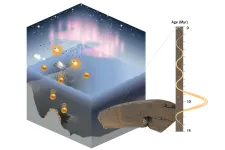(Press-News.org) Years before tau tangles show up in brain scans of patients with Alzheimer's disease, a biomarker test developed at the University of Pittsburgh School of Medicine can detect small amounts of the clumping-prone tau protein and its misfolded pathological forms that litter the brain, cerebrospinal fluid and potentially blood, new research published today in Nature Medicine suggests.
The cerebrospinal fluid biomarker test correlates with the severity of cognitive decline, independent of other factors, including brain amyloid deposition, thereby opening doors for early-stage disease diagnosis and intervention.
Since amyloid-beta pathology often precedes tau abnormalities in Alzheimer’s disease, most biomarker efforts have focused on early detection of amyloid-beta changes. However, the clumping of tau protein into well-ordered structures referred to by pathologists as “neurofibrillary tangles” is a more defining event for Alzheimer’s disease as it is more strongly associated with the cognitive changes seen in affected people.
“Our test identifies very early stages of tau tangle formation – up to a decade before any tau clumps can show up on a brain scan,” said senior author Thomas Karikari, Ph.D., assistant professor of psychiatry at Pitt. “Early detection is key to more successful therapies for Alzheimer’s disease since trials show that patients with little-to-no quantifiable insoluble tau tangles are more likely to benefit from new treatments than those with a significant degree of tau brain deposits.”
Since many elderly people who have amyloid-beta plaques in their brains will never go on to develop cognitive symptoms of Alzheimer's disease during their lifetime, the widely adopted diagnostics framework developed by the Alzheimer’s Association specifies the three neuropathological pillars necessary to diagnose the disease – combined presence of tau and amyloid-beta pathology and neurodegeneration. In a quest for early and accessible biomarkers for Alzheimer’s disease, Karikari’s earlier work showed that a brain-specific form of tau, called BD-tau, can be measured in blood and reliably indicate the presence of Alzheimer's disease-specific neurodegeneration. Several years prior, Karikari showed that specific forms of phosphorylated tau, p-tau181, p-tau217 and p-tau212, in the blood can predict the presence of brain amyloid-beta without the need for costly and time-consuming brain imaging.
But these tools largely detect amyloid pathology, so the issue of early detection of tau still looms large. While tau-PET remains a reliable and accurate predictor of tau burden in the brain, the test’s utility is limited by availability, low resolution, high cost, labor and sensitivity. At present, tau-PET scans can pick up the signal from neurofibrillary tangles only when a large number are present in the brain, at which point the degree of brain pathology has become pronounced and is not easily reversible.
In this latest research, using the tools of biochemistry and molecular biology, Karikari and team identified a core region of the tau protein that is necessary for neurofibrillary tangle formation. Detecting sites within that core region of 111 amino acids, a sequence they call tau258-368, can identify clumping-prone tau proteins and help initiate further diagnostics and early treatment. In particular, the two new phosphorylation sites, p-tau-262 and p-tau-356, can accurately inform the status of early-stage tau aggregation that, with an appropriate intervention, could potentially be reversed.
“Amyloid-beta is a kindling, and tau is a matchstick. A large percentage of people who have brain amyloid-beta deposits will never develop dementia. But once the tau tangles light up on a brain scan, it may be too late to put out the fire and their cognitive health can quickly deteriorate,” said Karikari. “Early detection of tangle-prone tau could identify the individuals who are likely to develop Alzheimer’s-associated cognitive decline and could be helped with new generation therapies.”
Other authors of this research are Eric Abrahamson, Ph.D., Xuemei Zeng, Ph.D., Anuradha Sehrawat, Ph.D., Yijun Chen, M.S., Tharick Pascoal, M.D., Ph.D., and Milos Ikonomovic, M.D., all of Pitt; Tohidul Islam, Ph.D., Przemysław Kac, M.S., Hlin Kvartsberg, Ph.D., Maria Olsson, B.S., Emma Sjons, B.S., Fernando Gonzalez-Ortiz, M.D., M.S., Henrik Zetterberg, M.D., Ph.D., and Kaj Blennow, M.D., Ph.D., all of University of Gothenburg, Sweden; Emily Hill, Ph.D., Ivana Del Popolo, M.S., Abbie Richardson, M.S., Victoria Mitchell, M.S., and Mark Wall, Ph.D., all of the University of Warwick, UK; Stijn Servaes, Ph.D., Joseph Therriault, Ph.D., Cécile Tissot, Ph.D., Nesrine Rahmouni, M.S., and Pedro Rosa-Neto, M.D., Ph.D., all of McGill University, Canada; Denis Smirnov, Ph.D., and Douglas Galasko, M.D., both of University of California, San Diego; Tammaryn Lashley, Ph.D., of University College London, UK.
This study was supported by, among others, the National Institute on Aging (grants R01AG083874, U24AG082930, P30AG066468, RF1AG052525-01A1, R01AG053952, R37AG023651, RF1AG025516, R01AG073267, R01AG075336, R01AG072641, P01AG14449, and P01AG025204, among others), the Swedish Research Council (grant 2021-03244), the Alzheimer’s Association (grant AARF-21-850325), the Swedish Alzheimer Foundation, the Aina (Ann) Wallströms and Mary-Ann Sjöbloms Foundation, the Emil and Wera Cornells Foundation and a professorial endowment fund from the Department of Psychiatry, University of Pittsburgh.
END
Biomarker test can detect Alzheimer's pathology earlier, Pitt study shows
2025-02-10
ELSE PRESS RELEASES FROM THIS DATE:
Anomaly in the deep sea
2025-02-10
Beryllium-10, a rare radioactive isotope produced by cosmic rays in the atmosphere, provides valuable insights into the Earth's geological history. A research team from the Helmholtz-Zentrum Dresden-Rossendorf (HZDR), in collaboration with the TUD Dresden University of Technology and the Australian National University (ANU), has discovered an unexpected accumulation of this isotope in samples taken from the Pacific seabed. Such an anomaly may be attributed to shifts in ocean currents or astrophysical events that occurred approximately 10 million years ago. The findings hold the potential to serve as a global time marker, representing a promising ...
Princeton neuroscientists crack the code of how we make decisions
2025-02-10
A new mathematical model sheds light on how the brain processes different cues, such as sights and sounds, during decision making. The findings from Princeton neuroscientists may one day improve how brain circuits go awry in neurological disorders, such as Alzheimer’s, and could help artificial brains, like Alexa or self-driving car technology, more helpful.
The findings were published February 10 in the journal Nature Neuroscience.
Walking to work, commuters encounter many sensory signals along their route, such as the glow of a crosswalk signal that indicates whether it’s safe to cross or beware of oncoming traffic. ...
Trump's 2024 election victory: A double-edged sword for the US stock market
2025-02-10
Financial markets are reacting not just to Donald Trump's return to the White House but also to the unpredictability of this victory, according to a new study from the University of Surrey. Investors must diversify their portfolios to mitigate risks associated with political volatility and to remain vigilant about the potential for abrupt market corrections.
A new study, published in Economics Letters, indicates that while there was an immediate surge in stock prices following Trump's election, this was quickly tempered by investor concerns over potential trade wars and international instability.
A group of ...
High-tech video optimization in our brain
2025-02-10
Why do our mental images stay sharp even when we are moving fast? A team of neuroscientists led by Professor Maximilian Jösch at the Institute of Science and Technology Austria (ISTA) has identified a mechanism that corrects visual distortions caused by movement in animals. The study, conducted in mice, identifies a core function that can be generalized across the vertebrate visual system, including primates such as humans. The findings are published in Nature Neuroscience.
Despite its rapid development in recent decades, the video camera industry is still catching up with the capabilities of the human eye. In particular, action cams are designed ...
Euclid discovers a stunning Einstein ring
2025-02-10
Euclid blasted off on its six-year mission to explore the dark Universe on 1 July 2023. Before the spacecraft could begin its survey, the team of scientists and engineers on Earth had to make sure everything was working properly. During this early testing phase, in September 2023, Euclid sent some images back to Earth. They were deliberately out of focus, but in one fuzzy image Euclid Archive Scientist Bruno Altieri saw a hint of a very special phenomenon and decided to take a closer look.
“I look at the data from Euclid as it comes in,” explains Bruno. “Even from that first observation, I could see it, but after Euclid made more observations of the area, ...
Biotech in Germany has significant potential, but lack of collaboration hampers growth
2025-02-10
The report “Assessing Deep-Tech Innovation Hubs in Germany: The Case of Biotechnology” evaluates Germany’s performance in deep-tech innovation within biotech using a comprehensive index and examines five key hubs: Berlin, Heidelberg, Munich, Nuremberg-Erlangen, and Stuttgart. These hubs were analyzed in terms of fundamental research, research and development in biotech, startup activity, public infrastructure, and business environment.
Berlin, Munich, and Heidelberg are the leading biotech hubs
Berlin leads the index due to its strong public infrastructure ...
Does pain affect cancer survivors’ use of non-opioid substances?
2025-02-10
Experiencing pain may increase the odds that cancer survivors will use cigarettes and cannabis, according to a recent study published by Wiley online in CANCER, a peer-reviewed journal of the American Cancer Society. The study also found that cigarette smoking and pain are linked to more treatment-related side effects and worse health among cancer survivors.
Pain and use of cigarettes, e-cigarettes, alcohol, and cannabis commonly occur together in the general population. To characterize pain in relation to such non-opioid substance ...
Scientists find that a playful approach to life activates ‘lemonading’, which helps people cope with adversity
2025-02-10
Scientists have found that taking a playful approach to life doesn’t mean you don’t take your situation seriously, but it can mean you cope with it better. By surveying people about their experiences during a Covid-19 lockdown, they learned that more playful people were more positive about the future and coped more actively and creatively. Life gave them lemons, and they made lemonade.
“Our study revealed that playfulness and resilience are intimately connected through what we call ‘lemonading’ — the ability to imagine ...
Candidate genes in canine hepatocellular carcinoma for molecular targeted therapy
2025-02-10
Unresectable canine hepatocellular carcinoma (HCC) has limited nonsurgical treatment options. Sorafenib is a targeted therapy for unresectable canine HCC. However, there are limited reports on the expression of target genes. Therefore, the efficacy of the targeted therapies for canine HCC remains unclear.
In HCC, the prognosis is generally good when complete surgical resection is possible. Unresectable nodular and diffuse HCC have a poor prognosis and limited nonsurgical treatment options. In humans, systemic therapies including ...
Opioid prescriptions in the ED linked to small increases in future opioid use, hospitalizations
2025-02-10
Opioid prescriptions in the emergency department (ED) were associated with small increases in later opioid prescriptions and hospital admissions, found new research published in CMAJ (Canadian Medical Association Journal) https://www.cmaj.ca/lookup/doi/10.1503/cmaj.241542.
To understand the relationship between opioid prescribing in the ED and subsequent harm, researchers looked at opioid prescribing at all Alberta EDs from 2010 to 2020. Of the more than 13 million visits, 689 074 patients (5.3%) filled an opioid prescription. The researchers found that opioid prescriptions did not increase the risk of ...





